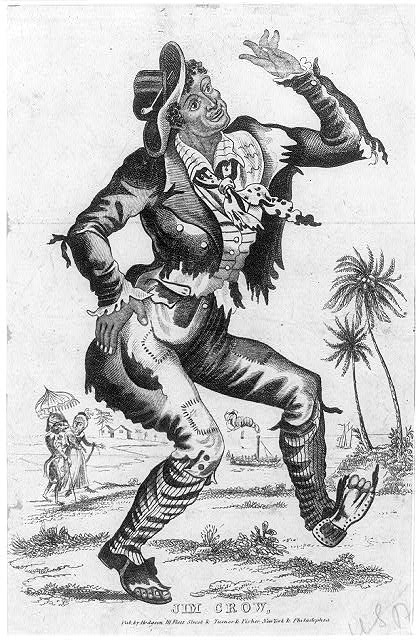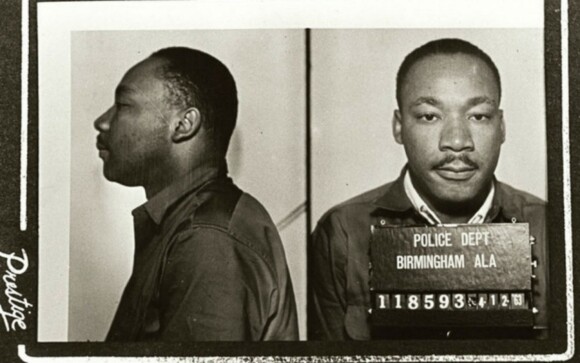Okay, In an earlier post where I talk about my origins as a civil rights activist. A White person a woman my age who actually grew up in the south with Black servants in her home

asked me where the term “Jim Crow” came from ….As most of you know I’m a historian…..so I took the bait….this is what I told her. …..”The Name Jim Crow comes from a song made popular by a white “minstrel” performer …the words went like this “”Come listen all you galls and boys,
I’m going to sing a little song,
My name is Jim Crow.
Weel about and turn about and do jis so,
Eb’ry time I weel about I jump Jim Crow.”………..”These words are from the song, “Jim Crow,” as it appeared in sheet music written by Thomas Dartmouth “Daddy” Rice. Rice, a struggling “actor” (he did short solo skits between play scenes) at the Park Theater in New York, happened upon a black person singing the above song — some accounts say it was an old black slave who walked with difficulty, others say it was a ragged black stable boy. Whether modeled on an old man or a young boy we will never know, but we know that in 1828 Rice appeared on stage as “Jim Crow” — an exaggerated, highly stereotypical black character.
Rice, a white man, was one of the first performers to wear blackface makeup — his skin was darkened with burnt cork. His Jim Crow song-and-dance routine was an astounding success that took him from Louisville to Cincinnati to Pittsburgh to Philadelphia and finally to New York in 1832. He also performed to great acclaim in London and Dublin. By then “Jim Crow” was a stock character in minstrel shows, along with counterparts Jim Dandy and Zip Coon. Rice’s subsequent blackface characters were Sambos, Coons, and Dandies. White audiences were receptive to the portrayals of blacks as singing, dancing, grinning fools.
By 1838, the term “Jim Crow” was being used as a collective racial epithet for blacks, not as offensive as nigger, but similar to coon or darkie. The popularity of minstrel shows clearly aided the spread of Jim Crow as a racial slur. This use of the term only lasted half a century. By the end of the 19th century, the words Jim Crow were less likely to be used to derisively describe blacks; instead, the phrase Jim Crow was being used to describe laws and customs which oppressed blacks.”…”Jim Crow was the name of the racial caste system which operated primarily, but not exclusively in southern and border states, between 1877 and the mid-1960s. Jim Crow was more than a series of rigid anti-black laws. It was a way of life. Under Jim Crow, African Americans were relegated to the status of second class citizens. Jim Crow represented the legitimization of anti-black racism. Many Christian ministers and theologians taught that whites were the Chosen people, blacks were cursed to be servants, and God supported racial segregation. Craniologists, eugenicists, phrenologists, and Social Darwinists, at every educational level, buttressed the belief that blacks were innately intellectually and culturally inferior to whites. Pro-segregation politicians gave eloquent speeches on the great danger of integration: the mongrelization of the white race. Newspaper and magazine writers routinely referred to blacks as niggers, coons, and darkies; and worse, their articles reinforced anti-black stereotypes. Even children’s games portrayed blacks as inferior beings ” EXAMPLES OF “JIM CROW” CUSTOMS AND LAWS…”
A black male could not offer his hand (to shake hands) with a white male because it implied being socially equal. Obviously, a black male could not offer his hand or any other part of his body to a white woman, because he risked being accused of rape.
Blacks and whites were not supposed to eat together. If they did eat together, whites were to be served first, and some sort of partition was to be placed between them.
Under no circumstance was a black male to offer to light the cigarette of a white female — that gesture implied intimacy.
Blacks were not allowed to show public affection toward one another in public, especially kissing, because it offended whites.
Jim Crow etiquette prescribed that blacks were introduced to whites, never whites to blacks. For example: “Mr. Peters (the white person), this is Charlie (the black person), that I spoke to you about.”
Whites did not use courtesy titles of respect when referring to blacks, for example, Mr., Mrs., Miss., Sir, or Ma’am. Instead, blacks were called by their first names. Blacks had to use courtesy titles when referring to whites, and were not allowed to call them by their first names.
If a black person rode in a car driven by a white person, the black person sat in the back seat, or the back of a truck.
White motorists had the right-of-way at all intersections.”….Stetson Kennedy, the author of Jim Crow Guide (1990), offered these simple rules that blacks were supposed to observe in conversing with whites:
Never assert or even intimate that a white person is lying.
Never impute dishonorable intentions to a white person.
Never suggest that a white person is from an inferior class.
Never lay claim to, or overly demonstrate, superior knowledge or intelligence.
Never curse a white person.
Never laugh derisively at a white person.
Never comment upon the appearance of a white female…..below a picture of the poster used to promote the theater act “Jump Jim Crow”
 asked me where the term “Jim Crow” came from ….As most of you know I’m a historian…..so I took the bait….this is what I told her. …..”The Name Jim Crow comes from a song made popular by a white “minstrel” performer …the words went like this “”Come listen all you galls and boys,
asked me where the term “Jim Crow” came from ….As most of you know I’m a historian…..so I took the bait….this is what I told her. …..”The Name Jim Crow comes from a song made popular by a white “minstrel” performer …the words went like this “”Come listen all you galls and boys, Follow
Follow

